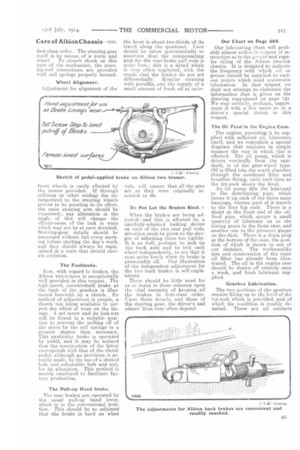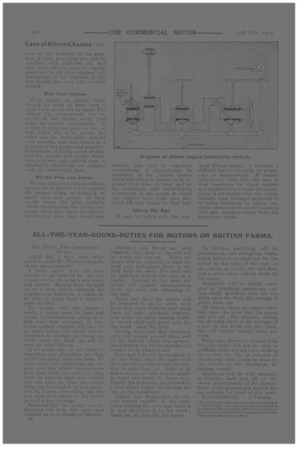Albion AlthouVI, as a rule, it is as Iv;11 to
Page 17

Page 19

Page 20

If you've noticed an error in this article please click here to report it so we can fix it.
" lei well alone," it needs care to ensure that all is always welt.
The second part of this, the fourth article of the present series, was published on pages 501,-503 of our last issue.
With further reference to chain adjustments, if it be desired to shorten one without replacing it a special half link may be inserted. Care should be taken to see that all split pins on chain bolts are opened and well fitted. After adjusting chains, hand brakes require inspection, to ensute that no alteration has taken place in their engagement. We write of the proper lubrication of chains towards the end of the present article.
The Special Radius Rods.
And now a few words with regard to the radius rods. These, as we have said, are of special design on the Albion chassis, and have proved mest effective in use Theoadiusrod body is formed of pressed steel, with a steel stamping riveted to its front end. A gun-metal adjusting screw, which is an easy fit on the spindle of this stamping, is retained in place by a steel nut. Provision is made at this end for lateral flexibility by a special pin joint. When it is desired to adjust the chains, the large nut is turned downwards, which has the effect of extending the effective length of
the radius rod. The loeknut, of course, has to be slacked before and tightened up after this operation.
At the rear portion of the radiusrod body, a thick fibre strip is inserted, which allows a certain amount of flexibility in a transverse direction. The radius rods require no attention beyond. keeping the adjusting gear clean, and seeing that it is properly lubricated.
We have already published an illustration which shows the degree of care that has been taken by the designers to ensure proper and efficient lubrication of road wheels and mountings. All four wheels are provided with plain gunmetal bushes, and it is the practice of the maker to recommend, their lubrication with castor oil. Large plugs are provided in the huh caps ; their removal gives access to the axle ends. End Play of Road Wheels.
It is important to try all the road wheels from time to time for end play ; both front and rear wheels should revolve freely when turned by hand, and only a small amount of lateral slackness should be permitted. If this be considerable, it should be taken up by removing the hub cap and tightening up the nut which holds the collet in position. If it he found that the thrust washers have worn, new ones will remedy the defect.
In the case of the back wheels of all chain-driven models, wear on the inner thrust washers may allow the road wheel to get out of line and so to alter the alignment of the chain drive New washers must be supplied in all such cases, in order to avoid undue wear of the chain. Care should be taken to replace all split pins in the axle ends after any such adjustment.
Importance of Steering Efficiency We have illustrated the steering gear details sufficiently to demonstrate the substantial nature of the whole of the fittings. The ball joints are carried on the tops of the levers in the modern way, and the cups which engage with them are substantial and easily assembled. There is no excuse for anyone in charge of an Albion model who allows the steering-gear connecting rods and levers to get out of order. So much depends, too, upon the efficacy of this part of the chassis, that too much insistence cannot be placed upon the necessity of its being maintained in first-class order. The steering gear itself is by means of a worm and wheel. To absorb shock on this part of the mechanism, the steering-rod connections are provided with coil springs properly housed.
Wheel Alignment. Adjustment for alignment of the front wheels is easily effected by the means provided. If through collision or other mishap the derangement to the steering wheels proves to be puzzling in its effect, the main steering arm should be examined ; any alteration in the angle of this will change the effectiveness of the lock in ways which may not be at once detected. Steering-gear details should be examined without fail every morning before starting the day's work, and they should always be maintained in a state that should obviate criticism, The Footbrake.
Now, with regard to brakes, the Albion two-tonner is exceptionally well provided in this respect. The high-speed, countershaft brake at the back of the gearbox is illustrated herewith by a sketch. Its method, of adjustment is simple, a thumb nut being available to correct the effect of wear on the linings. A set screw and its lock-nut will be found in a suitable position to prevent the pulling off of the shoes by the coil springs to a greater degree than necessary. This particular brake is operated by pedal, and it may be noticed that the construction of the latter corresponds with that of the clutch pedal, although no provision is actually made, by the use of a slotted hole and adjustable bolt and nut, for its alteration. This method is merely employed to facilitate factory production.
the lever is about two-thirds of its travel along the quadrant. Care should be taken systematically to ascertain that the compensating gear for the rear-brake pull rods is quite free ; this is a detail which is very often neglected, with the result that the brakes do not act differentially. Regular cleaning with paraffin, and the supply of ,a
i small amount of fresh oil at nter
vals, will ensure that all the pins act as they were originally intended to do.
Do Not Let the Brakes Bind.
When the brakes are being adjusted—and this is effected by a carefully-schemed locking device on each of the two rear pull rods, attention must be given to the danger of adjusting them too tightly. It is as well, perhaps, to jack up the back axle and to test each wheel independently, to see that it runs quite freely when its brake is presumably off. Our illustration of the independent adjustment for the two back brakes is self-explanatory.
There should be little need for its to insist in these columns upon the vital necessity of keeping all the brakes in first-class order. Upon these details, and those of the steering gear, the driver's and others' lives very often depend. Our Chart on Page 524.
Our lubricating chart will probably almost suffice in rospect of instruction as to the proper and regular oiling of the Albion two-ton chassis. It is designed to indicate the frequency with which oil or grease should be supplied to various points which need systematic lubrication. In that respect we shall not attempt to elaborate the information that is givca on the drawing reproduced on page ";24. We may usefully, perhaps, supplement it with a few notes as to a driver's special duties in this respect.
The Oil Feed in the Engine Case.
The engine, providing it, be supplied with sufficient oil, lubricates itself, and we reproduce a special diagram that explains in simple manner the way in which this is effected. The oil pump, which is driven vertically from the camshaft, is of the gear-wheel type. Oil is filled into the crank chamber through the combined filler and breather fitting, until such time as the try-cock shows the level.
An oil pump lifts the lubricant to the distributing pipe, which forces it up each of the three main bearings, whence part of it travels to the four big ends. There is a shunt at the front end of the oilfeed pipe, which sprays a small quantity of lubricant on to the timing gears in the front. case, and another one to the pressure gauge on the dash. There is a drain plug at the bottom of the. case, the position of which is shown in one of our sketches. The workmanlike size and construction of the main oil filter has already been illustrated. The oil in the engine case should be drawn off entirely once a week, and fresh lubricant supplied.
Gearbox Lubrication.
The two portions of the gearbox require filling up to the level of the try-cock which is provided, and of which the condition is readily detected. There are oil catchers
ever all the hearings in the gearhex. so that, provi.r.iing this Mitt be supplied with ;,utflii:ient oil, and
fry,1:1 mOe _L-L'o.e it regular intervals tl.ie old oHio drained out, lubrication or the eontents of this box shoull give very little trciulde indeed.
Boil Your Chains.
With regard to chains, these should be oiled it least once a week from an 1..,i1-can by hand. Ti, Albion Le. recommends tie to
moval of the fiVury lOtO IniieS for rarnfil c.amiriation. It keep Liii paiN. n isp, so
that w IIIe is in sort ice tile other can be thoroughly cleaned with paraflin. and then boiled in a
mixt el hot grease and graphite Lubrication of all the other details, and the regular and proper attention to grwtse caps and oil cups, is scheduled-effectively we imagine —on our lubricating chart.
Oil the Pins and Joints.
\Ve can lea% c the subject io.ith ri injunction to drivers not to neglect the proper oiling or greasing of striail pins and joints. If they would retain the quiet running for the first tirri.e. they would hest
achieve that end by regularly ascertaining if adjustments be necessary at the various points where alteration is known to be re (wired from time to tune, and by the systematic and never-failing lubrioation at the points at which the makers have with care provided efficient means to that end.
Albion Old Age.
If etu:n be taken \t it!, the stan. 'laid Albion chassis, it becomes a difficult matter to settle its proper rate of depreciation. If owners and drivers alike take tin' care of their machines for which makers and designers have made provision, there is no reason why the exceptionally long mileages achieved in so many instances by Albion hines should not be as well secured with any standard model from the Scotstoun works.


























